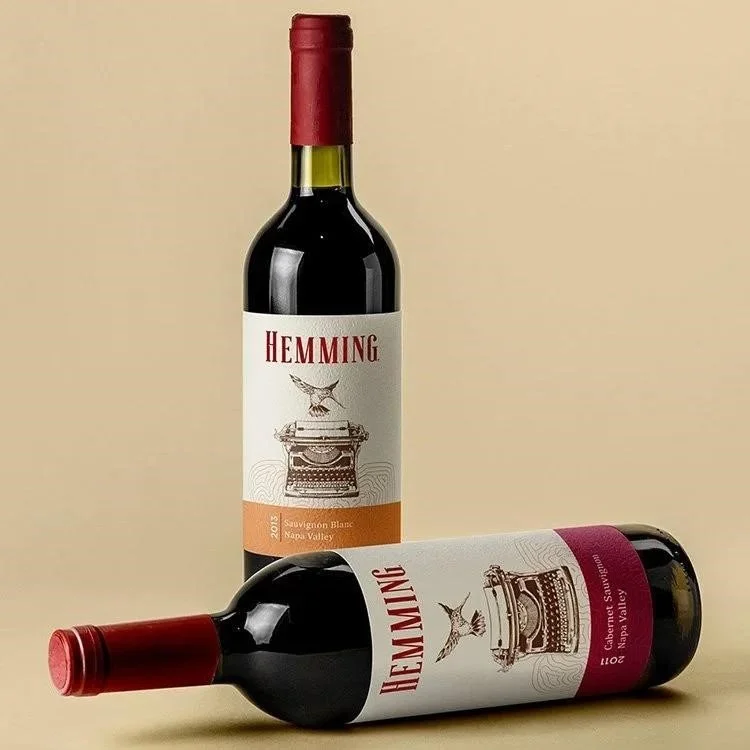Beverage label design shapes first impressions, nudges fast decisions, and carries your brand promise from the shelf to the cart. In a space where shoppers scan quickly, a clear hierarchy, impactful brand storytelling and credible claims turn up the sales numbers without inflating costs. When visuals, materials, and messaging work in sync, the label becomes a performance asset rather than a simple package design.
In this blog, we will explore high-performing beverage label design strategies in 2025 to maximize the shelf appeal of your beverage brand.
Beverage Label Design Essentials
A winning system balances emotion with function. Start with purpose, then layer creative choices that make the product unmistakable at a glance.
Typographic clarity: Limit to one primary family and one supporting family, keep contrast high, and set minimum sizes for cooler visibility.
Visual hierarchy: Lead with product name, flavor or variant, then one proof point that reinforces value in seconds.
Color strategy: Maintain a clear color strategy that can help implement label design across multiple SKUs.
Material fit: Choose facestocks and adhesives that withstand condensation, abrasion, and cold-chain handling.
Information integrity: Present credible claims and nutritional values in a logical, scannable order.
Implementing best beverage label design strategies in 2025 is a smart foundation for brands aiming to boost sales.
Storytelling with Beverage Label Graphics
Beverage label graphics should deliver a focused narrative that aligns with the buyer’s intent. Let imagery and structure explain what the drink is, why it meets the buyer’s need, and how it differs.
Express Origin, Wellness, Or Energy
Origin and craft: Hand-drawn ingredients, micro motifs, and provenance markers convey authenticity without clutter.
Wellness and clarity: Minimal layouts, generous white space, and transparent ingredient language signal honesty and purity.
Energy and excitement: High-contrast compositions, angled elements, and vivid tones support functional or caffeinated offerings.
Premium Without Noise
When beverage graphic design introduces foil, emboss, or spot varnish, use them sparingly and keep embellishments away from mandatory copy and barcodes to preserve utility. This is where thoughtful beverage label graphics reinforce brand cues while respecting readability and retail realities.
Trending beverage label design options in 2025 include transparent beverage labels for juices that spotlight liquid color and purity, or eco-friendly beverage label graphics materials that reflect responsible choices without sacrificing durability.
Production, Compliance and Sustainability
The best designs falter if labels fail in the real world. Specify clear label strategy early to avoid rework and protect timelines.
Choose Substrates That Survive Retail
Moisture-resistant films and cold-temperature adhesives prevent edge lift in chillers and ice buckets.
Scuff-resistant overlaminates protect artwork during transport and stocking.
Test on curved surfaces and textured containers to verify adhesion and legibility.
Design Within Clear Guardrails
Maintain minimum sizes and contrast for required statements and nutrition details.
Reserve quiet zones for barcodes and date codes to ensure fast scans.
Create a beverage label compliance checklist to standardize legal reviews across markets and categories.
Signal Responsibility Credibly
Favor FSC papers, recycled or bio-based films, and water-based inks where feasible.
Right-size labels to reduce material use without losing presence.
State sustainability benefits plainly to avoid mixed signals or perceived greenwashing.
Optimization Checklist and Quick Wins
Small, targeted adjustments can yield outsized impact, especially when you have an existing line and limited time.
Increase font size of brand and flavor name until they read clearly from 6 to 10 feet.
Place one concise proof point near the flavor title, for example zero sugar or real fruit.
Avoid dense paragraphs. Instead use a 3 to 4 icon system that summarizes core benefits.
Codify a color family per flavor to speed recognition across the set.
Add a QR to the product information page for deeper engagement that reinforces trust.
Conclusion: Turn Beverage Label Design into A Conversion Engine
Beverage label design performs best when clarity, credibility, and character come together at the moment of choice. Align hierarchy and messaging with real shopper missions, let beverage label graphics tell a tight story, and select materials that thrive in chillers and logistics. With the right system, brands win attention faster, build trust sooner, and earn repeat purchase more often.
Lien Design brings a human-centered process and proven execution that elevate products from good to unforgettable, helping teams translate strategy into shelf impact.
Ready to lift conversions with a sales-focused refresh that looks as good as it performs? Request a price estimate with Lien Design today.
FAQs
1. How long does a label refresh typically take?
Most teams complete a refresh in 4 to 10 weeks, covering research, concepts, revisions, prepress, and print sampling. Compressed timelines work when the brief is focused, decision makers are aligned, and printer specs are locked early.
2. Which finishes most improve perceived quality?
Selective foil on signatures, soft-touch matte coatings, and subtle emboss on brandmarks often deliver the best lift when used judiciously. Prioritize tactile moments where shoppers hold the product, then validate that finishes do not interfere with scanners or required copy.
3. How can variants stay distinct yet cohesive?
Lock a master grid with a fixed logo zone and information stack. Differentiate SKUs through color families, illustration styles, and accent motifs while keeping type styles, layout rhythm, and claim placement consistent for fast recognition.
4. How do I pick the right label size and shape?
Measure the flat printable area, avoid seams, and print a quick paper mockup to check fit and readability at arm’s length. Leave space for barcodes and dates. For curved bottles, use a full wrap or split front/back labels. Choose a silhouette that cleanly frames your logo and flavor, and keep important text away from edges.
Read More: How to make a beverage label stand out




